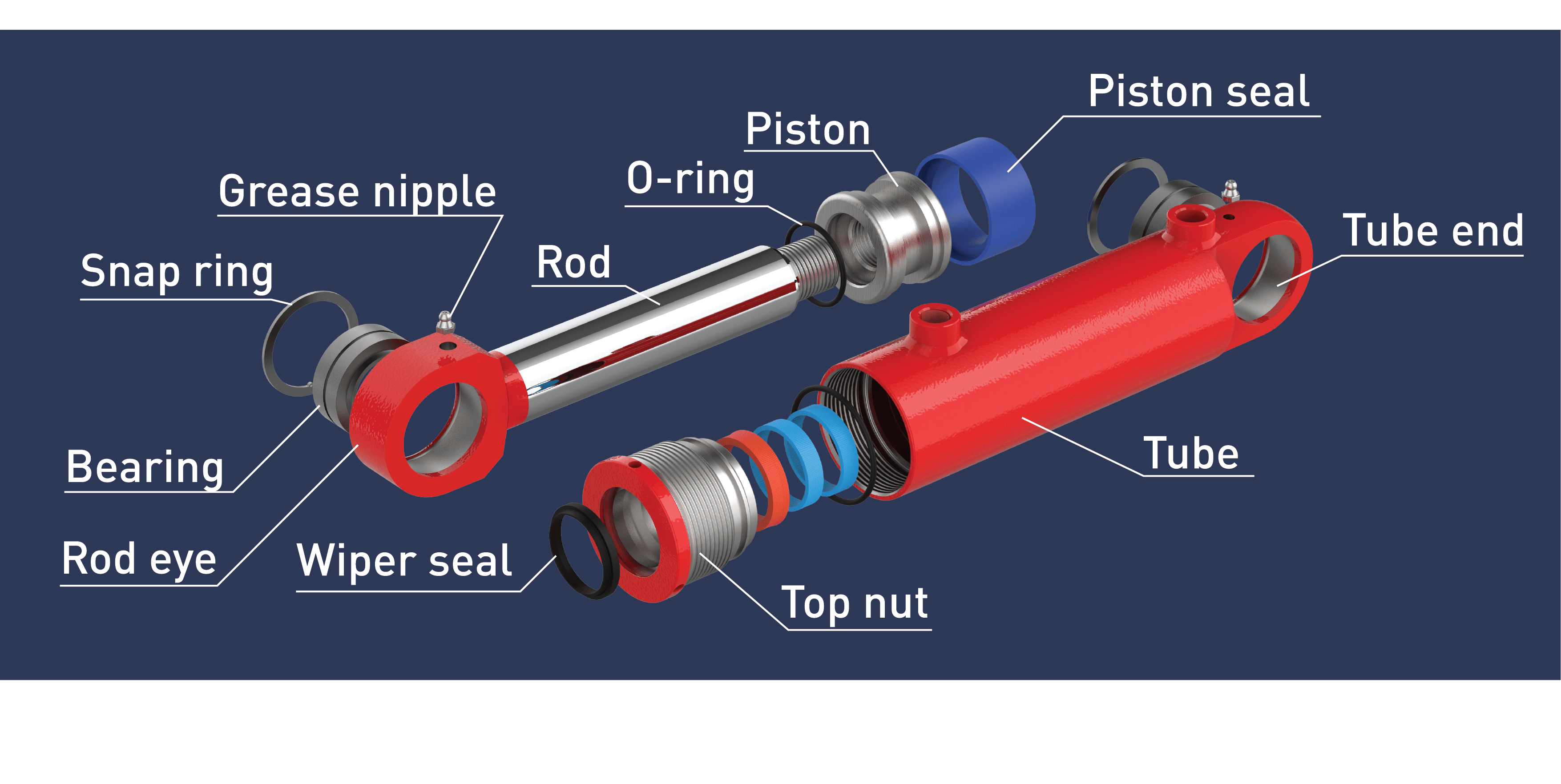What is a hydraulic cylinder?
What are hydraulic cylinders? Hydraulic cylinders are everywhere around us, we see them in our daily life all the time without maybe even realizing if we don’t specifically pay attention: in excavators, trucks, forklifts, tractors, aerial platforms, mining equipment – you name it. Hydraulic cylinder is one of the four main components of a hydraulic system, whereas hydraulic system is a technology where fluid, most commonly hydraulic oil, is used to move energy from a motor to an actuator: most commonly, a hydraulic cylinder.
Hydraulic cylinder is a part of a machine’s hydraulic system. Simply said, hydraulic cylinder is a hydraulic actuator which creates linear movement by converting the hydraulic energy back to a mechanical movement. Hydraulic cylinder can be compared to a muscle; with the machine’s hydraulic system, it creates the movement – therefore it is like a muscle.
In the hydraulic transmission, the medium is liquid, usually oil, of which we are also talking about this text. The basic concept of hydraulics is that when the power machine rotates the pump, a volume flow is formed (the volume of liquid passing through the cross-section per unit of time, which’s unit in the SI is m3/s). The pressure of the hydraulic system is determined by the load which is caused either with the cylinder or valve which then resists the flow of the liquid flow caused by the hydraulic pump.
The pressure spreads evenly to every direction in the system and effects to all hydraulic system’s closed spaces’ surfaces evenly; this effect is called Pascal’s law.
So, the pressure is generated when the force effects to the item’s surface. When the force is divided with area, we get the pressure as follows:
p= F/A(where: F = force [N, Newton]; |
So, cylinder’s hydraulic energy is transformed back to a mechanical movement. When the pressure comes to chamber A, the rod pushes out and therefore the force pushes out (F = p x A1). As counter motion in a double acting cylinder as the pressure comes to chamber B, the rod retreats in and also the force retreats in (F = p x A2)
Example illustration: an illustrated cross-section of a double-acting hydraulic cylinder.

Single-acting or double-acting hydraulic cylinder?
There are single-acting and double acting hydraulic cylinders. As it can be deduced from the name, the single-acting cylinders only operate to one direction; hydraulics move the rod to one direction and the counter motion happens by itself or by a mechanical structure or by an external load. In a single-acting cylinder there might not be a piston at all, only a piston rod and the oil pressure effect to the cross area of the piston rod which causes it to move outwards. A forklift truck is one example where single-acting hydraulic cylinders are used.
Double acting hydraulic cylinders operate to two directions; the cylinder is moved to two directions with hydraulics as in back and forth or out and in. Piston separates the chamber and as the oil pressure effects the piston, the piston moves the rod – the oil effects to the piston’s front or back (example illustration 2) – when the cylinder rod moves to both directions. Double acting cylinders are used for example in excavator’s booms; the excavator’s coop needs to be moved back and forth and these both movements require a great amount of force.
A double acting hydraulic cylinder’s structure is illustrated in the picture below:

 The mission of the seals is to keep the oil in the right place; in the case of a hydraulic cylinder the oil needs to stay in the right chambers. There are different kinds of seals. For example, an O-ring or other kind of pressure seal are placed in a groove: as the oil flows, the oil pressure pushes the seal to the other end of the groove and the seal is compressed and presses to the sealing surfaces and prevents the oil leaking pass it. All pressure seals work with the same principle. An O-ring is the most simple seal there is in a hydraulic cylinder.
The mission of the seals is to keep the oil in the right place; in the case of a hydraulic cylinder the oil needs to stay in the right chambers. There are different kinds of seals. For example, an O-ring or other kind of pressure seal are placed in a groove: as the oil flows, the oil pressure pushes the seal to the other end of the groove and the seal is compressed and presses to the sealing surfaces and prevents the oil leaking pass it. All pressure seals work with the same principle. An O-ring is the most simple seal there is in a hydraulic cylinder.
Various hydraulic functions can be integrated to hydraulic cylinders. For example, hydraulic components including flow, load control or pressure valves can be integrated to the cylinder.
Different kinds of sensors can also be integrated to the cylinder; different kinds of position and pressure sensors can tell about the fatigue the cylinder is facing and they also give exact information about the pressure inside the cylinder. According to the position information, the speed of the cylinder can be calculated whereas the pressure sensor gives information about the cylinder’s force. If there are sensors integrated to the cylinder, with Hydroline’s technology LEO, it is possible to calculate the cylinder’s experience and compare it to the cylinder’s theoretical lifetime. Learn more about LEO here.


